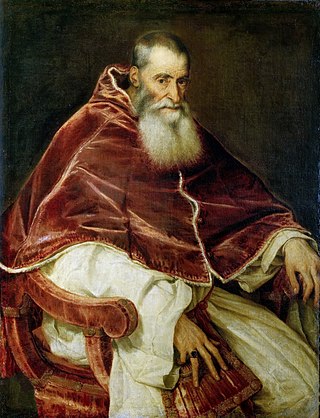
Annibale Carracci was an Italian painter and instructor, active in Bologna and later in Rome. Along with his brother and cousin, Annibale was one of the progenitors, if not founders of a leading strand of the Baroque style, borrowing from styles from both north and south of their native city, and aspiring for a return to classical monumentality, but adding a more vital dynamism. Painters working under Annibale at the gallery of the Palazzo Farnese would be highly influential in Roman painting for decades.

Museo di Capodimonte is an art museum located in the Palace of Capodimonte, a grand Bourbon palazzo in Naples, Italy designed by Giovanni Antonio Medrano. The museum is the prime repository of Neapolitan painting and decorative art, with several important works from other Italian schools of painting, and some important ancient Roman sculptures. It is one of the largest museums in Italy. The museum was inaugurated in 1957.

Pope Paul III and His Grandsons is an oil on canvas painting by Titian, housed in the Museo di Capodimonte, Naples. It was commissioned by the Farnese family and painted during Titian's visit to Rome between autumn 1545 and June 1546. It depicts the scabrous relationship between Pope Paul III and his grandsons, Ottavio and Alessandro Farnese. Ottavio is shown in the act of kneeling, to his left; Alessandro, wearing a cardinal's dress, stands behind him to his right. The painting explores the effects of ageing and the manoeuvring behind succession; Paul was at the time in his late seventies and ruling in an uncertain political climate as Charles V, Holy Roman Emperor came into ascendancy.

Portrait of Pope Paul III is anoil on canvas portrait by Titian of Pope Paul III, produced during the pope's visit to Northern Italy, in 1543. It is in the collection of the Museo di Capodimonte, in Naples.

Sacrificial Scene is a grisaille tempera on canvas painting by Pontormo, produced around 1520 and now in the National Museum of Capodimonte in Naples. It was probably originally produced as part of the decoration of an interior in honour of Cosimo de' Medici.

Self-Portrait at a Spinet is an oil-on-canvas painting by the Italian artist Sofonisba Anguissola, from c. 1555. It is held in the National Museum of Capodimonte, in Naples.

Portrait of Philip II is an oil on canvas portrait by Titian of Philip II of Spain wearing the chain of the Order of the Golden Fleece. It is in the collection of the Museo di Capodimonte, in Naples.

Portrait of Pier Luigi Farnese is a heavily-damaged oil on canvas painting of Pier Luigi Farnese, Duke of Parma by Titian, from 1546. It is now in Room 2 of the Museum of Capodimonte, in Naples.

The Child Bitten by A Lobster is a drawing by the Italian painter Sofonisba Anguissola, executed in chalk and pencil on light blue paper, and dated to around 1554. It is in the collection of the Museo di Capodimonte, in Naples.

Christ Crowned with Thorns or Christ Mocked is a 1598–1600 oil on canvas painting by Annibale Carracci, now at the Pinacoteca Nazionale di Bologna.

Elena Barozzi was a celebrated Venetian patrician.

Madonna and Child with Donors or Sacred Conversation with Donors is a c. 1525 oil on panel painting by Palma Vecchio, now in the Museo nazionale di Capodimonte in Naples.

Penitent Magdalene is a c. 1550 oil on canvas painting by Titian, now in the Museo di Capodimonte in Naples.

Portrait of Cardinal Alessandro Farnese is a c. 1545–46 oil on canvas three-quarter-length portrait of Alessandro Farnese the Younger (1520–1589) by Titian. It is held in the Museo di Capodimonte, in Naples.

Portrait of Pope Paul III with Camauro is an oil on canvas painting by Titian, from c. 1545-1546. It is held in the Museo nazionale di Capodimonte, in Naples.

Portrait of Charles V or Portrait of a Man Wearing the Order of the Golden Fleece is an oil on canvas painting by Titian, from c. 1549. It is held now in the Museo di Capodimonte, in Naples.

Saint Jerome or Penitent Saint Jerome is an oil-on-canvas painting executed c.1640–1650 by the Italian artist Guercino, now in the Royal Palace of Naples.

Saint Joseph's Dream is an oil-on-canvas painting executed ca. 1615–1650 by the Italian Baroque artist Guercino, now in the Royal Palace of Naples.

Democritus is an oil on canvas painting by the Italian painter Agostino Carracci, from c. 1596. It depicts the ancient Greek philosopher Democritus. It is held in the Museo di Capodimonte, in Naples.

Apollo and Marsyas is a 1637 oil on canvas painting by Jusepe de Ribera, now in the Museo nazionale di Capodimonte in Naples. Heavily influenced by Caravaggio, he produced another version, also in 1637, now in the Royal Museums of Fine Arts of Belgium in Brussels.





















